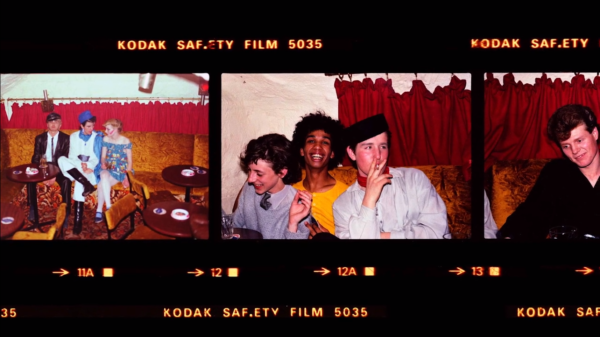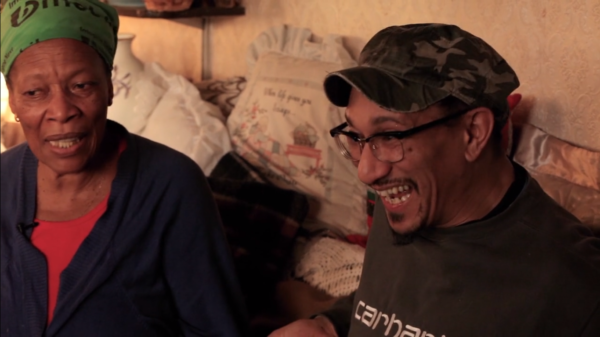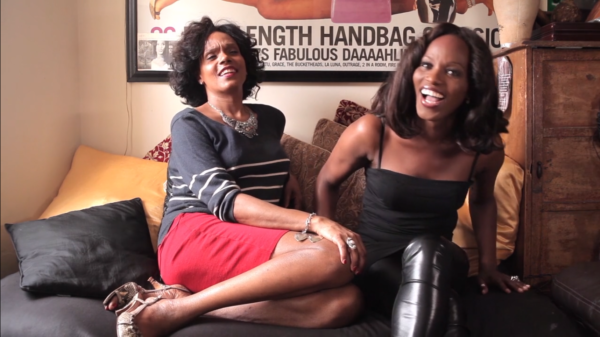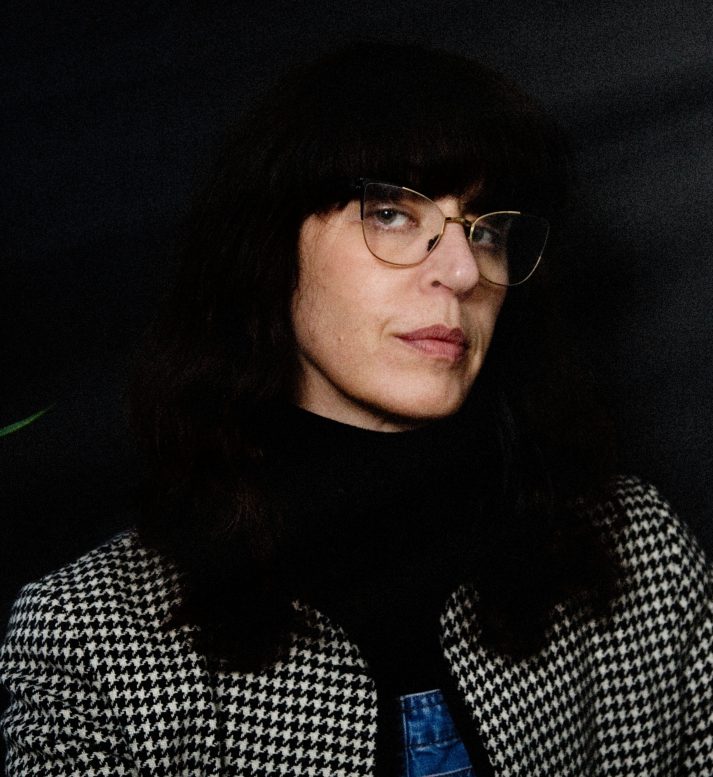Best British – Beyond ‘There’s always a black issue Dear’
The Iris Blogger talks to photographer and filmmaker Claire Lawrie
Beyond ‘There’s always a black issue, dear’ features interviews with queer members of the British black community, looking back at their experiences of growing up in the 1960s and ’70s. It’s been shortlisted for this year’s
Best British award, sponsored by Pinewood Studios. The Iris Blogger spoke with director Claire Lawrie about the film.
Iris Blogger: The interviewees are very warm and candid. Were they people you already knew?
 Claire Lawrie:
Claire Lawrie: I've known most of them for many years. We would have met through the London club scene. They were all people that I looked up to, admired and was inspired by, and as I've grown up they still are. The people that I didn’t know well I knew
of, because they were all connected to what was quite a small scene in the 1980s and early ’90s.
IB: You've done a considerable amount of work as a photographer, especially portraits. Do you see documentary as an extension of your photography, or is it something completely different?
CL: The genesis for the film really came from the experience of making the photo.
(See above.) It was a brilliant day in so many ways. I shot it whilst two major retrospectives on the 1980s club scene were showing in London, both lacked the voices of black and LGBTQ figures, and I decided to do something about that omission. It’s that do-it-yourself attitude that permeates throughout the film, and in many ways echoes the attitude of the cast and of the times we grew up in. I really like the record of the shoot, you can see and feel the grassroots nature of the day, which was very much about just gathering and celebrating the group, what they mean to the collective history of London’s alternative club, fashion and dance scene and what they mean to their friends and collaborators.
IB: Beyond… covers a lot of ground in 30mins. How much footage did you shoot, and how do you go about choosing what to use and what to cut?
 CL:
CL: There’s an avalanche of information in there, ten lifetimes’ worth so far, plus the thoughts of the inimitable Vee Davis, who is one of the interviewees’ mothers! The interviews were each about 2 hours long, but I’ve spent many, many more hours over the last 5 years assembling this edit. I taught myself how to use the software, and gathered archive from different artists who have collaborated with the interviewees or myself over the years, all of whom donated footage and images to the project. I worked with the cast’s stories, using dialogue that I felt worked to build a vivid picture of their experiences. This is an amazing group of people discussing their family life, their growing up and their many achievements, which happened to coincide with a time of pivotal change for LGBTQ and for black communities in the UK.
IB: Do you see the film as self-contained and finished, or is it a project you'd like to expand on?
CL: This is the first cut, I am expanding it, but I’m being careful to keep it true to my original intentions. I am working with Blackout UK to fundraise for postproduction costs so that it can be totally finished by the beginning of 2019.
IB: The subjects in the film all grew up in the 1960s and '70s. How do you think the black queer experience in Britain has changed since then?
 CL:
CL: I can’t really answer that because I don’t live that experience, but I think that looking back to the 1970s and ’80s, even though so much has completely changed, I would say that there is still no room for complacency. When I talk to my friends who are in the film and to my younger friends, that’s how they feel as well. The film shows that black and LGBTQ lives were – and still are – as central to any discussions on British culture, fashion, music, dance and fine arts, as any other voices, but what I felt was that despite that, when this much-documented period of history is evaluated or curated, we were only getting to see and hear one part of the picture, when the whole picture is so much better!
 Claire Lawrie: I've known most of them for many years. We would have met through the London club scene. They were all people that I looked up to, admired and was inspired by, and as I've grown up they still are. The people that I didn’t know well I knew of, because they were all connected to what was quite a small scene in the 1980s and early ’90s.
IB: You've done a considerable amount of work as a photographer, especially portraits. Do you see documentary as an extension of your photography, or is it something completely different?
CL: The genesis for the film really came from the experience of making the photo. (See above.) It was a brilliant day in so many ways. I shot it whilst two major retrospectives on the 1980s club scene were showing in London, both lacked the voices of black and LGBTQ figures, and I decided to do something about that omission. It’s that do-it-yourself attitude that permeates throughout the film, and in many ways echoes the attitude of the cast and of the times we grew up in. I really like the record of the shoot, you can see and feel the grassroots nature of the day, which was very much about just gathering and celebrating the group, what they mean to the collective history of London’s alternative club, fashion and dance scene and what they mean to their friends and collaborators.
IB: Beyond… covers a lot of ground in 30mins. How much footage did you shoot, and how do you go about choosing what to use and what to cut?
Claire Lawrie: I've known most of them for many years. We would have met through the London club scene. They were all people that I looked up to, admired and was inspired by, and as I've grown up they still are. The people that I didn’t know well I knew of, because they were all connected to what was quite a small scene in the 1980s and early ’90s.
IB: You've done a considerable amount of work as a photographer, especially portraits. Do you see documentary as an extension of your photography, or is it something completely different?
CL: The genesis for the film really came from the experience of making the photo. (See above.) It was a brilliant day in so many ways. I shot it whilst two major retrospectives on the 1980s club scene were showing in London, both lacked the voices of black and LGBTQ figures, and I decided to do something about that omission. It’s that do-it-yourself attitude that permeates throughout the film, and in many ways echoes the attitude of the cast and of the times we grew up in. I really like the record of the shoot, you can see and feel the grassroots nature of the day, which was very much about just gathering and celebrating the group, what they mean to the collective history of London’s alternative club, fashion and dance scene and what they mean to their friends and collaborators.
IB: Beyond… covers a lot of ground in 30mins. How much footage did you shoot, and how do you go about choosing what to use and what to cut?
 CL: There’s an avalanche of information in there, ten lifetimes’ worth so far, plus the thoughts of the inimitable Vee Davis, who is one of the interviewees’ mothers! The interviews were each about 2 hours long, but I’ve spent many, many more hours over the last 5 years assembling this edit. I taught myself how to use the software, and gathered archive from different artists who have collaborated with the interviewees or myself over the years, all of whom donated footage and images to the project. I worked with the cast’s stories, using dialogue that I felt worked to build a vivid picture of their experiences. This is an amazing group of people discussing their family life, their growing up and their many achievements, which happened to coincide with a time of pivotal change for LGBTQ and for black communities in the UK.
IB: Do you see the film as self-contained and finished, or is it a project you'd like to expand on?
CL: This is the first cut, I am expanding it, but I’m being careful to keep it true to my original intentions. I am working with Blackout UK to fundraise for postproduction costs so that it can be totally finished by the beginning of 2019.
IB: The subjects in the film all grew up in the 1960s and '70s. How do you think the black queer experience in Britain has changed since then?
CL: There’s an avalanche of information in there, ten lifetimes’ worth so far, plus the thoughts of the inimitable Vee Davis, who is one of the interviewees’ mothers! The interviews were each about 2 hours long, but I’ve spent many, many more hours over the last 5 years assembling this edit. I taught myself how to use the software, and gathered archive from different artists who have collaborated with the interviewees or myself over the years, all of whom donated footage and images to the project. I worked with the cast’s stories, using dialogue that I felt worked to build a vivid picture of their experiences. This is an amazing group of people discussing their family life, their growing up and their many achievements, which happened to coincide with a time of pivotal change for LGBTQ and for black communities in the UK.
IB: Do you see the film as self-contained and finished, or is it a project you'd like to expand on?
CL: This is the first cut, I am expanding it, but I’m being careful to keep it true to my original intentions. I am working with Blackout UK to fundraise for postproduction costs so that it can be totally finished by the beginning of 2019.
IB: The subjects in the film all grew up in the 1960s and '70s. How do you think the black queer experience in Britain has changed since then?
 CL: I can’t really answer that because I don’t live that experience, but I think that looking back to the 1970s and ’80s, even though so much has completely changed, I would say that there is still no room for complacency. When I talk to my friends who are in the film and to my younger friends, that’s how they feel as well. The film shows that black and LGBTQ lives were – and still are – as central to any discussions on British culture, fashion, music, dance and fine arts, as any other voices, but what I felt was that despite that, when this much-documented period of history is evaluated or curated, we were only getting to see and hear one part of the picture, when the whole picture is so much better!
CL: I can’t really answer that because I don’t live that experience, but I think that looking back to the 1970s and ’80s, even though so much has completely changed, I would say that there is still no room for complacency. When I talk to my friends who are in the film and to my younger friends, that’s how they feel as well. The film shows that black and LGBTQ lives were – and still are – as central to any discussions on British culture, fashion, music, dance and fine arts, as any other voices, but what I felt was that despite that, when this much-documented period of history is evaluated or curated, we were only getting to see and hear one part of the picture, when the whole picture is so much better! 
